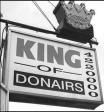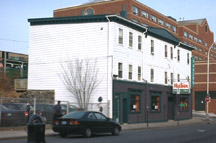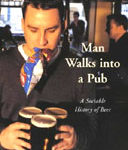Things seen in Napanee this afternoon. The Square Boy Pizza logo must be one of the last dot matrix brands left. I didn’t catch if the restaurant was inferior or superior.
Category: Pubs, Tavs, Diners and Restaurants
Sophat Vann
Unbeknownst to me last Saturday night, I ate at one of the favourite spots of Ra McGuire, the lead singer from Trooper. It’s information like that that doesn’t change your life but might lead one to pause over one’s Phanaeng Goong (spicy shrimp in basil peanut coconut sauce). [If I see him, there bending over noodle soup noisily, I will call him “Trooper Boy” – I will, I will…]
 The Whig last Saturday had a great full page on Mr. Vann…or Mr. Sophat…who has started five different Cambodian restaurants in downtown Kingston – he starts one, gets it going, sells it to someone he trains for a few months and then goes on to open another. When I first moved here I asked whether there had been an immigration wave at some point, thinking it would take a fair number of families from one culture to sustain five restaurants. I got some odd looks. It was, I now learn, a one-man piece of work, creating a momentum for the stuff that helps keep the downtown thriving. Way to go. I have only attended one of his earlier shops, Cambodian Village, so far but his own kitchen Cambodiana is right around the corner.
The Whig last Saturday had a great full page on Mr. Vann…or Mr. Sophat…who has started five different Cambodian restaurants in downtown Kingston – he starts one, gets it going, sells it to someone he trains for a few months and then goes on to open another. When I first moved here I asked whether there had been an immigration wave at some point, thinking it would take a fair number of families from one culture to sustain five restaurants. I got some odd looks. It was, I now learn, a one-man piece of work, creating a momentum for the stuff that helps keep the downtown thriving. Way to go. I have only attended one of his earlier shops, Cambodian Village, so far but his own kitchen Cambodiana is right around the corner.
 This is the way it should work. Coming from Nova Scotia, I was used to Lunenburg Greeks, the Lebanese of 1948, the Greeks of the mid-50’s, the Vietnamese of the mid-70’s, the Lebanese of the late 70’s, a guy in my class called Zoltan whose folks got out in ’56, and the former Yugoslavs and their neighbours in the 90’s – and ate their sausage, kibbe, mousakka, croissants (remember the guy at North and Agricola who was a Saigon french pastry chef?), donairs, kapusta and other stuff. In undergrad, I wouldn’t trust a pizza not made by a guy who wasn’t raised on the Mediterranean. I would eat their mother’s home cooking, whatever it was. Food should be an entry to the immigrant experience for the non-immigrant. Eat curry and nans when you are 18 and get a little understanding of understand Mr. Khana, the grade 12 supply math teacher who posed unbelievably hard questions to keep us from being little bastards. Eat a donair from Sam Kasam and Lebanon is a little less about terrorists. Have apples and honey and listen to a friend’s grandfather quiz the young rabbi into embarrassment, think about the menorah. Share a joke over Tom Yum Goong and the jokes at the expense
This is the way it should work. Coming from Nova Scotia, I was used to Lunenburg Greeks, the Lebanese of 1948, the Greeks of the mid-50’s, the Vietnamese of the mid-70’s, the Lebanese of the late 70’s, a guy in my class called Zoltan whose folks got out in ’56, and the former Yugoslavs and their neighbours in the 90’s – and ate their sausage, kibbe, mousakka, croissants (remember the guy at North and Agricola who was a Saigon french pastry chef?), donairs, kapusta and other stuff. In undergrad, I wouldn’t trust a pizza not made by a guy who wasn’t raised on the Mediterranean. I would eat their mother’s home cooking, whatever it was. Food should be an entry to the immigrant experience for the non-immigrant. Eat curry and nans when you are 18 and get a little understanding of understand Mr. Khana, the grade 12 supply math teacher who posed unbelievably hard questions to keep us from being little bastards. Eat a donair from Sam Kasam and Lebanon is a little less about terrorists. Have apples and honey and listen to a friend’s grandfather quiz the young rabbi into embarrassment, think about the menorah. Share a joke over Tom Yum Goong and the jokes at the expense ![]() of others quickly sour. All in the cause of shaking up the brain and its residue of preconceptions through tasty food.
of others quickly sour. All in the cause of shaking up the brain and its residue of preconceptions through tasty food.
Even though I am the kid of two immigrants, I don’t, however, expect to see diners based on smoked herring and haggis. Your loss. Maybe in south-east Asia there are trendy corner stalls with chip butties and Irn-Brew…and deep fried Mars bars.
Midtown Tavern, Halifax, Nova Scotia
 Midtown Tavern, R.I.P. David Swick has the whole story in Halifax Daily News.
Midtown Tavern, R.I.P. David Swick has the whole story in Halifax Daily News.
A city that prides itself on its heritage, and a legendary tavern whose days are numbered. Sounds like a match made in tippling heaven. Operators of the Midtown Tavern in downtown Halifax have applied to the city to tear the old place down, to be replaced by a new drinking spot in a 20-storey hotel. Chances are good that this will actually happen. Times have changed. Even 10 years ago, the Midtown was hot, hot, hot. But plain decor and basic food are no longer the key to success.
“We still serve a tonne of food [Ed.: Dave, even I don’t think Mr. Grant was thinking metric], but no one’s drinking anymore,” says Eric Grant, one of two sons of longtime owner Doug Grant. “We used to break even with the food and make money on the beer. You can’t do that if people don’t drink. If you won the lottery tomorrow and told me you wanted to open a tavern, I’d say you were crazy.”
Doug Grant, now 78, has told his kids they can do what they want, Eric said. So they worked with a developer to create a plan, and are now taking calls from hotel chains, with an eye to putting a fancy new bar at the base of 20 storeys of rooms. Rather than unceremoniously destroy the Midtown, tourism and heritage officials might consider picking it up and moving it. Plunked down somewhere else in town, it could become a curious attraction. Here, after all, is a tavern that did not change for decades — and stayed enormously popular through almost all of that time.
We’ll never see its like again.
Boiled dinner, two and juice. Even in my Halifax time, 1981 to 1992, you passed through the Midtown on your way to other bars, the Deck or the Seahorse. Now it would be a stop or more likely a walk by on the way to Rogues Roost. It wasn’t the same after Jerry moved on a long time ago. He held the place open for us on a blizzardy Friday night.
Around 1984, I saw an oil painting of the Midtown jazzy on a rainy evening for $400.00. I kick my own arse thinking about not buying it. I had steak and egg and two and juice there before seeing Gretzky play for Canada ona Saturday afternoon in September 1983 against the Czeckoslovaks with Hasek either in goal or on the bench as a kid. I think I have had a beer with three-quarters of my best friends in that bar.
Man Walks Into a Pub, by Pete Brown
 I bought another beer book. I picked up a copy of “Man Walks into a Pub” by Pete Brown on Thursday after noon and it was done by Sunday. Not bad for guy with kiddies. The Guardian said:
I bought another beer book. I picked up a copy of “Man Walks into a Pub” by Pete Brown on Thursday after noon and it was done by Sunday. Not bad for guy with kiddies. The Guardian said:
So, as well as the irreverent approach Brown takes to beer’s history, he has a refreshingly sensible take on its present.
Sensible is an interesting word. Most beer books are written by nerdy homebrewers or self-appointed gurus like Michael Jackson. Both have a technical interest or at least the desire to impart a reverence for the subject. …I hope the bag of chips are for him…Brown is an advertising executive who has handled both the Heineken and Stella Artois accounts and a someime talking head for TV in the UK on things beery. It shows. He treats fans of real ale as hobbiest and treats them with slightly less contempt than temperence unionists and government regulators. But most of the time not without reason.
That being said, the book is easily accessible, funny and, but for a few factual errors you would only know after having a collection of books and subscriptions to a couple of magazine about beer, a pretty good history of the subject from a 2003 English, rather than even British, perspective. Unlike any other book I have read, Brown focuses on why and how people in England actually drink beer, how they are affected by advertising and changes in pub ownership, and how lager has come to dominate the market while being vapid bubble water – even if from something of a natural apologist’s point of view.
Find a pint of Hook Norton Haymaker or Old Hooky and have a giggle at the expense of lager drinkers.



